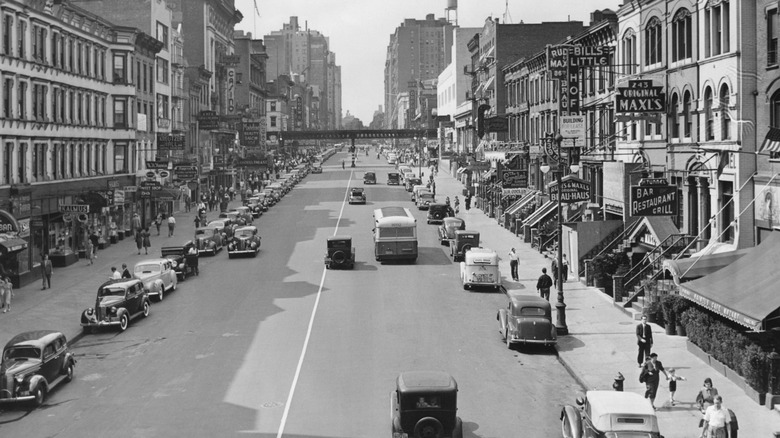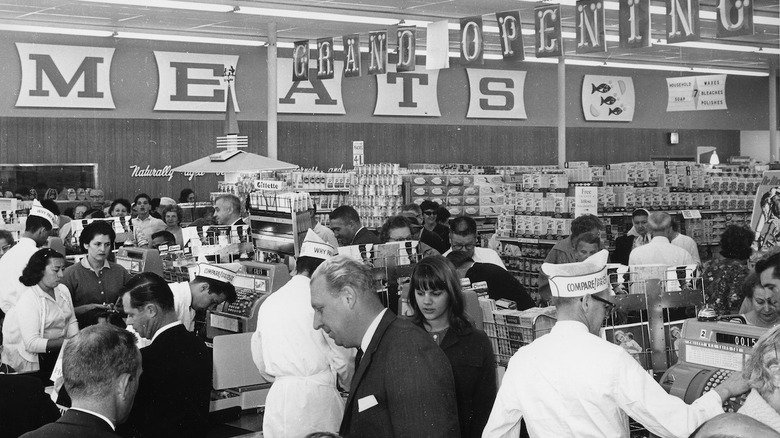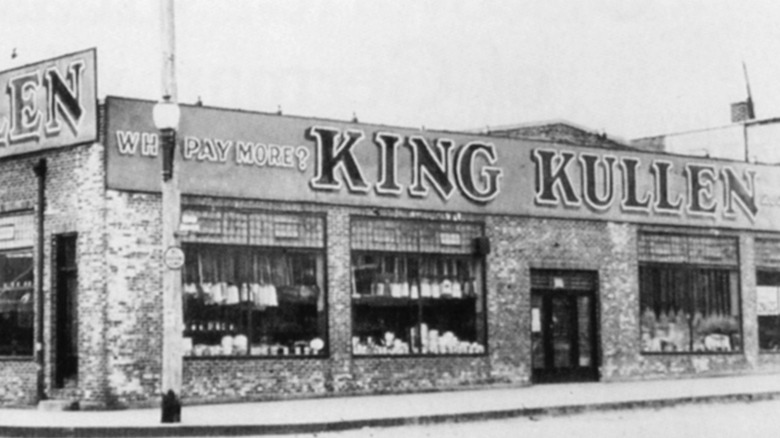How America's First Supermarket Was Different From All The Others
These days, the supermarket is the place where most Americans get their groceries. But as hard as it may be to imagine, this wasn't always so. In many parts of the world, and in most of U.S.history, people purchased items from a number of different stores. Buying from the bakery, butcher shop, fishmonger, and dairy farmer entailed separate trips to different locations. But in the first half of the 20th century, things changed, and 1930 saw the birth of the first store considered a true supermarket as we know it today. King Kullen (whose original Queens location is still in operation) opened its doors and spawned a revolution in American purchasing.
But first things first: What counts as a supermarket? The Southern supermarket chain Piggly Wiggly takes the honors as the first store to offer self-serve foodstuffs, one important factor in the supermarket equation. But it was King Kullen that really paved the way, as it was the first to provide all five of the key features Smithsonian considers necessary to a true modern supermarket: "separate departments; self-service; discount pricing; chain marketing; and volume dealing." Until the advent of the supermarket in 1930, most people shopped daily for items they needed, but not for much else. Supermarket shopping created a true revolution in the American grocery experience.
Cars, fridges, and a desire for savings led to the birth of the first supermarket
As with any revolution, there were a number of contributing factors that made the moment ripe for grocery-shopping invention. Three of the key elements were a dramatic increase in automobile ownership, improvements in refrigeration, and increasing price sensitivity. During the 1930s, car-owning households in the U.S. hit 50% for the first time, per Bloomberg. The refrigerator (first invented in 1913) saw its first widespread use in 1927, due to improvements in technology, according to Apartment Therapy.
Car access and refrigeration were paramount to the supermarket's rise, since the large volume that supermarkets aim for requires both easy transportation of goods and storage of those items once people get home. Bulk purchasing also depends on people seizing a deal: To convince customers to come home with more than they needed, supermarkets offered prices too good to pass up, enticing shoppers with both variety and affordability. According to the book "Savoring Gotham" (via Bowery Boys History), King Kullen delivered on these fronts in spades.
A food shopping revolution
The original supermarket "stocked thousands of food products — about ten times more than other grocery stores — at prices that undercut those at local markets," per "Savoring Gotham" (via Bowery Boys History). "There was also free curbside parking drawing in customers with cars, who tended to stock up rather than just buying a few items for immediate use."
As with most modern revolutions, this one had an author: King Kullen's founder, Michael J. Cullen. Born in Newark, New Jersey, this forward-thinking pioneer got started in the grocery business at age 18, when he started working for the A&P chain. After nearly two decades with A&P, he moved on to Kroger in 1920. Nine years later, he was general sales manager of the branch in Herrin, Illinois. The prototype of the modern supermarket had already hatched in his brain, and in 1929, Cullen wrote a letter pitching his novel idea to Kroger's president.
The pitch is a marvelous testament to an astute entrepreneur and American dreamer. Per Hoover's World, he described a supermarket that would be "monstrous in size" with "80% self-service" and "plenty of parking." He then detailed how some items would be sold at cost, while several would be marked up. "Can you imagine how the public would respond to a store of this kind? ... Nobody in the world ever did this before," he wrote, adding that he was "so confident" in his plan that he would invest $15,000 of his own money to make it happen.
King in Queens
Ultimately, no one at Kroger was moved by Cullen's letter, and his offer was rejected. Unfazed by the setback, Cullen quit his job with Kroger, moved his family to Long Island, and opened a store of his own. The store's name was inspired by a picture his young son drew at the time, depicting a man sitting on a globe and a title which neatly synthesized the dominance Cullen sought for his new market model: "King Kullen" (via Bowery Boys History). Bobby's misspelling of their last name was fortuitous: Dad approved, and the store that Cullen marketed as "the world's greatest price wrecker" opened its doors on August 4, 1930, in the Jamaica Estates neighborhood.
King Kullen's success was immediate. People came from miles away to take advantage of the store's vast array of products and prices. King Kullen soon opened more branches in Queens, Brooklyn, and Long Island, followed by imitators that cropped up quickly. By 1936, there were 17 King Kullen branches in the New York area, according to Funding Universe. Unfortunately, Cullen's death that same year may have limited the chain's potential for expansion. While the supermarket grew and maintained a strong presence in the immediate area (it's still an important chain in Long Island), it never went national like others that came after it. King Kullen itself may not be on top of the world, but there is no disputing that Cullen's innovations ushered in a shopping model that has reigned supreme for a century.



